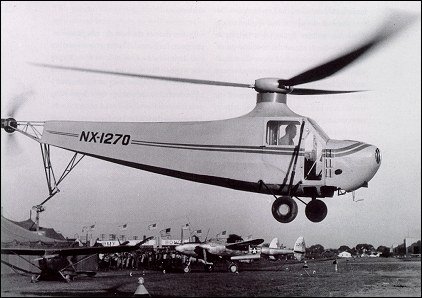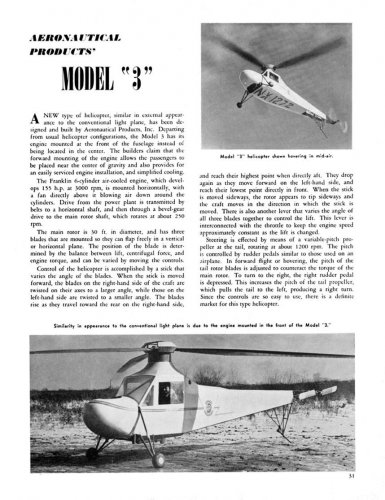- Joined
- 25 June 2009
- Messages
- 13,783
- Reaction score
- 3,068
When I started the topics on pre-war and post-war aircraft one-offs, my intention was always to start the corresponding rotorcraft topics... So here is the postwar "one-off" thread at last!
Let's begin with the Aeronautical Products A-1 [NX1270].
This was designed by Corwin Denny and Karl Schakel, two undergraduate engineers of the University of Michigan when they were working for the Aeronautical Products Corporation in Detroit. Although they soon left the company, Aeronautical Products Inc. — which normally manufactured aircraft engine parts — continued to work on the helicopter design they had initiated.
Built of welded-steel tubular construction, the Denny and Schakel helicopter was a single-seater with enclosed cabin, employing an auxiliary tail rotor for torque correction. The main rotor was 9m in diameter and was powered by a 90 hp engine. The gross weight of the craft was reported to be approximately 540 kg. It had a fixed tricycle landing gear. The pilot sits behind the engine, which is mounted in the nose. A long shaft extends under the pilot's seat and is geared to the vertical shaft of the rotor.
The aircraft was damaged during preparations for the first trial flights, but it was rebuilt and eventually flew successfully. It was not, however, actually put into production.
Sources:
Let's begin with the Aeronautical Products A-1 [NX1270].
This was designed by Corwin Denny and Karl Schakel, two undergraduate engineers of the University of Michigan when they were working for the Aeronautical Products Corporation in Detroit. Although they soon left the company, Aeronautical Products Inc. — which normally manufactured aircraft engine parts — continued to work on the helicopter design they had initiated.
Built of welded-steel tubular construction, the Denny and Schakel helicopter was a single-seater with enclosed cabin, employing an auxiliary tail rotor for torque correction. The main rotor was 9m in diameter and was powered by a 90 hp engine. The gross weight of the craft was reported to be approximately 540 kg. It had a fixed tricycle landing gear. The pilot sits behind the engine, which is mounted in the nose. A long shaft extends under the pilot's seat and is geared to the vertical shaft of the rotor.
The aircraft was damaged during preparations for the first trial flights, but it was rebuilt and eventually flew successfully. It was not, however, actually put into production.
Sources:
- H. F. Gregory "Anything a Horse Can Do. The story of the Helicopter", 1944


